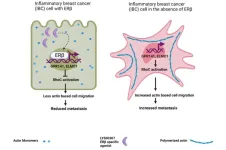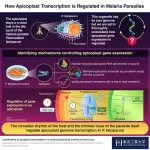(Press-News.org) CHAPEL HILL, N.C. – Cancer spreads throughout the human body in cunning, almost militaristic, ways. For example, it can manipulate our genetic make-up, take over specific cell-to-cell signaling processes, and mutate key enzymes to promote tumor growth, resist therapies, and hasten its spread from the original site to the bloodstream or other organs.
Enzyme mutations have been of great interest to scientists who study cancer. Scientists in the Liu and Tan labs at UNC’s Lineberger Comprehensive Cancer Center have been studying mutations of enzyme recognition motifs in substrates, which may more faithfully reflect enzyme function with the potential to find new targets or directions for cancer treatment.
“We think understanding the roles of mutations on enzyme substrates, instead of the enzyme as a whole, may help to improve efficacy of targeted therapies, especially for enzymes that have both oncogenic and tumor suppressive function through controlling distinct subsets of substrates,” said Jianfeng Chen, PhD, who is first author and a postdoctoral fellow in the Liu lab in the UNC Department of Biochemistry and Biophysics.
Their results were published in Journal of Experimental Medicine on June 29, 2023.
AGC Kinase Motif Mutations
Using the developed algorithm and information from The Cancer Genome Atlas (TCGA), they found that the highest rate of mutation occurs in the AGC kinase motif called RxRxxS/T. RxRxxS/T is a short, recurring pattern that is shared among the AGC family of ~60 kinases. These enzymes play critical roles in metastasis, proliferation, drug resistance, and development.
“We found that cancer tried to either evade or create mutations on these RxRxxS/T motifs to give itself more advantages for tumor growth and survival,” said Pengda Liu, PhD, who is an associate professor of biochemistry and biophysics.
A New Mechanism for Colorectal Cancer
The Liu and Tan groups conducted a validation study on the AGC kinase motif mutations associated with colorectal cancer, the second most lethal cancer and the third most prevalent malignant tumor worldwide. Currently, colorectal cancer has a 5-year survival rate of 12%.
They discovered that colon cancer “hijacks” BUD13 mutations, a protein-coding gene, to sidestep the phosphorylation that are carried out by AGC kinase. Colon cancer ultimately prefers these BUD13 mutations because it gains an additional benefit by inactivating an E3 ligase called Fbw7. “Turning off” Fbw7, a crucial tumor suppressor, causes an increase in tumor growth and therapy resistance.
In addition to their findings on Fbw7 inactivation, the research team also found that the BUD13 tumor cells were more susceptible to the inhibition of mTORC2 kinase, revealing a new, potential targeted therapy for colon cancer patients bearing that have the BUD13 mutation.
“It is exciting to teasing out different types of somatic mutations and we are glad to offer this publicly available resources to cancer research community,” said Xianming Tan, PhD, who is a research associate professor in the Department of Biostatistics in the Gillings School of Public Health and the Lineberger Comprehensive Cancer Center.
To search for protein motif mutations in the TCGA database, click here.
END
Researchers identify a new mechanism, cancer hijacks enzyme substrate motif mutations
Using a newly developed algorithm and a validation study, two labs in the UNC School of Medicine find that cancer hijacks a class of enzyme motif mutations to fuel tumorigenesis.
2023-07-03
ELSE PRESS RELEASES FROM THIS DATE:
Researchers develop tool that could improve liquid biopsy
2023-07-03
A research team led by Xianghong Jasmine Zhou, PhD, professor of Pathology and Laboratory Medicine at the David Geffen School of Medicine at UCLA, has made an important advancement to address one of the major challenges in cell-free DNA (cfDNA) testing, also known as liquid biopsy. They’ve identified specific methylation patterns unique to each tissue, potentially helping to Identify the specific tissue or organ associated with cfDNA alterations picked up by testing, a critical challenge for accurate diagnosis and monitoring of diseases.
Cell-free DNA has significant potential in disease detection and monitoring. However, accurately quantifying tissue-derived ...
Cigarette smoke and HPV have synergistic effects on cells, heightening the risk of head and neck cancer
2023-07-03
Tobacco smoking and human papillomavirus (HPV) are both well-known risk factors for head and neck cancer, but there is ample evidence to show they can interact to increase still further the risk of contracting the disease, according to a study by scientists at the University of São Paulo (USP) in Brazil and the University of Chile. An article on the study is published in the International Journal of Molecular Sciences.
The results of the study clarify aspects of the molecular mechanisms ...
ERβ as a mediator of estrogen signaling in inflammatory breast cancer
2023-07-03
“The mechanism of the anti-metastatic activity of ERβ was investigated [...]”
BUFFALO, NY- July 3, 2023 – A new editorial paper was published in Oncotarget's Volume 14 on June 12, 2023, entitled, “ERβ as a mediator of estrogen signaling in inflammatory breast cancer.”
In this new editorial, researchers Harika Nagandla and Christoforos Thomas from Houston Methodist Neal Cancer Center discuss inflammatory breast cancer (IBC)—a rare and aggressive form of breast ...
Pathogenic bacteria use a sugar in the intestinal mucus layer to infect the gut, study shows
2023-07-03
A new study by researchers at the University of British Columbia (UBC) and BC Children’s Hospital shows the sugar sialic acid, which makes up part of the protective intestinal mucus layer, fuels disease-causing bacteria in the gut.
The findings, published in PNAS, suggest a potential treatment target for intestinal bacterial infections and a range of chronic diseases linked to gut bacteria, including inflammatory bowel disease (IBD), celiac disease, irritable bowel syndrome and short bowel syndrome.
“Bacteria need to find a place in our intestines to take hold, establish and expand, and then they need to overcome all the different defences that normally protect our ...
Birds raise fewer young when spring arrives earlier in a warming world
2023-07-03
Rising global temperatures are making it harder for birds to know when it’s spring and time to breed according to a new study published in Proceedings of the National Academy of Sciences.
A large collaboration led by scientists at UCLA and Michigan State University has found that birds produce fewer young if they start breeding too early or late in the season. With climate change resulting in earlier springlike weather, the researchers report, birds have been unable to keep pace.
And, the authors write, the mismatch between the ...
Chemists discover why photosynthetic light-harvesting is so efficient
2023-07-03
When photosynthetic cells absorb light from the sun, packets of energy called photons leap between a series of light-harvesting proteins until they reach the photosynthetic reaction center. There, cells convert the energy into electrons, which eventually power the production of sugar molecules.
This transfer of energy through the light-harvesting complex occurs with extremely high efficiency: Nearly every photon of light absorbed generates an electron, a phenomenon known as near-unity quantum efficiency.
A new study from MIT chemists offers a potential explanation for how proteins of the light-harvesting complex, also called the antenna, achieve that ...
Planting seeds: FSU researchers dig into how chemical gardens grow
2023-07-03
EMBARGOED UNTIL JULY 3 AT 3 P.M. ET
FOR IMMEDIATE RELEASE
CONTACT: Kathleen Haughney, University Communications
(850) 644-1489; khaughney@fsu.edu
July 2023
PLANTING SEEDS: FSU RESEARCHERS DIG INTO HOW CHEMICAL GARDENS GROW
TALLAHASSEE, Fla. — Since the mid-1600s, chemists have been fascinated with brightly colored, coral-like structures that form by mixing metal salts in a small bottle.
Until now, researchers have been unable to model how these deceptively simple tubular structures —called chemical gardens — work and the patterns and rules that ...
Understanding the regulation of apicoplast gene expression in the malaria parasite
2023-07-03
Gene expression within the apicoplast, an organelle in the malaria parasite Plasmodium falciparum, is regulated by melatonin (the circadian signaling hormone) in host blood, and intrinsic parasite cues, via a factor called ApSigma, as identified by a recent study aided by Tokyo Tech’s World Research Hub Initiative. The regulatory system highlighted in this study might be a future target for malaria treatment.
Malaria is one of the biggest public health risks, with around 240 million people from across the globe contracting it every year. However, this life-threatening disease is ...
Study suggests resistance training can prevent or delay Alzheimer’s disease
2023-07-03
Regular physical exercise, such as resistance training, can prevent Alzheimer’s disease, or at least delay the appearance of symptoms, and serves as a simple and affordable therapy for Alzheimer’s patients. This is the conclusion of an article published in Frontiers in Neuroscience by Brazilian researchers affiliated with the Federal University of São Paulo (UNIFESP) and the University of São Paulo (USP).
Although older people and dementia patients are unlikely to be able to do long daily runs or perform other high-intensity aerobic exercises, these activities are the focus for most scientific studies on ...
First direct visualization of a zero-field pair density wave
2023-07-03
UPTON, NY—In the field of superconductivity—the phenomenon in which electrons can flow through a material with essentially zero resistance—the “holy grail” of discovery is a superconductor that can perform under everyday temperatures and pressures. Such a material could revolutionize modern life. But currently, even the “high-temperature” (high-Tc) superconductors that have been discovered must be kept very cold to function—too cold for most applications.
Scientists still have much to learn before room-temperature ...
LAST 30 PRESS RELEASES:
Scalable and healable gradient textiles for multi‑scenario radiative cooling via bicomponent blow spinning
Research shows informed traders never let a good climate crisis go to waste
Intelligent XGBoost framework enhances asphalt pavement skid resistance assessment
Dual-function biomaterials for postoperative osteosarcoma: Tumor suppression and bone regeneration
New framework reveals where transport emissions concentrate in Singapore
NTP-enhanced lattice oxygen activation in Ce-Co catalysts for low-temperature soot combustion
Synergistic interface engineering in Cu-Zn-Ce catalysts for efficient CO2 hydrogenation to methanol
COVID-19 leaves a lasting mark on the human brain
Scientists use ultrasound to soften and treat cancer tumors without damaging healthy tissue
Community swimming program for Black youth boosts skills, sense of belonging, study finds
Specific depressive symptoms in midlife linked to increased dementia risk
An ‘illuminating’ design sheds light on cholesterol
Who is more likely to get long COVID?
Study showcases resilience and rapid growth of “living rocks”
Naval Research Lab diver earns Office of Naval Research 2025 Sailor of the Year
New Mayo-led study establishes practical definition for rapidly progressive dementia
Fossil fuel industry’s “climate false solutions” reinforce its power and aggravate environmental injustice
Researchers reveal bias in a widely used measure of algorithm performance
Alcohol causes cancer. A study from IOCB Prague confirms damage to DNA and shows how cells defend against it
Hidden viruses in wastewater treatment may shape public health risks, study finds
Unlock the power of nature: how biomass can transform climate mitigation
Biochar reshapes hidden soil microbes that capture carbon dioxide in farmland
Reducing saturated fat intake shows mortality benefit, but only in high-risk individuals
Manta rays create mobile ecosystems, study finds
Study: Mixed results in using lipoic acid to treat progressive multiple sclerosis
Norbert Holtkamp appointed director of Fermi National Accelerator Laboratory
New agentic AI platform accelerates advanced optics design
Biologists discover neurons use physical signals — not electricity — to stabilize communication
Researchers discover that a hormone can access the brain by hitchhiking
University of Oklahoma researcher awarded funding to pursue AI-powered material design
[Press-News.org] Researchers identify a new mechanism, cancer hijacks enzyme substrate motif mutationsUsing a newly developed algorithm and a validation study, two labs in the UNC School of Medicine find that cancer hijacks a class of enzyme motif mutations to fuel tumorigenesis.



